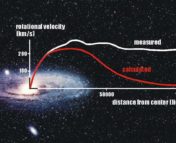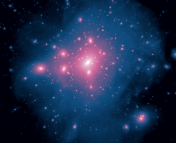Title: Dark Matter Halos as Particle Colliders: A Unified Solution to Small-Scale Structure Puzzles from Dwarfs to Clusters
Authors: M. Kaplinghat, S. Tulin, H.-B. Yu
First Author’s Institution: Department of Physics and Astronomy, University of California, Irvine, CA
The very large helps us to learn about the very small, as anyone who’s stubbed a toe—rudely brought face to face with the everyday quantum reality of Pauli’s exclusion principle and the electrostatic repulsion of electrons—knows. Astrophysics, the study of the largest things in existence, is no less immune to this marvelous fact. One particularly striking example is dark matter. It’s been a few decades since we realized that it exists, but we remain woefully unenlightened as to what this mysterious substance might be made of. Theories on its nature are legion—it’s hot! it’s cold! it’s warm! it’s sticky! it’s fuzzy! it’s charged! it’s atomic! it’s MACHO! it’s WIMP-y! it’s a combo of the above!
How are we to navigate and whittle down this veritable circus of dark matter particle theories? It turns out that an assumption about the nature of the subatomic dark matter particle can lead to observable effects on astrophysical scales. The game of tracing from microphysics to astrophysics has identified a clear set of dark matter properties: it’s cold (thus its common appellation, “cold dark matter,” or CDM, for short), collisionless, stable (i.e. it doesn’t spontaneously decay), and neutrally charged (unlike protons and electrons). CDM’s been wildly successful at explaining many astrophysical observations, except for one—it fails to reproduce the small scale structure of the universe (that is, at galaxy cluster scales and smaller). Dark matter halos at such scales, for instance, are observed to have constant-density cores, while CDM predicts peaky centers.
What aspect of the dark matter particle might we have overlooked that can explain away the small scale problems of CDM? One possibility is that dark matter is “sticky.” Sticky dark matter particles can collide with other dark matter particles, or are “self-interacting” (thus the model’s formal name, self-interacting dark matter, or SIDM for short). Collisions between dark matter particles can redistribute angular momentum in the centers of dense dark matter halos, pushing particles with little angular momentum in the centers of peaky dark matter halos outwards—producing cores. If you know how sticky the dark matter is (quantitatively described by the dark matter particle’s self-interaction cross section, which gives the probability that two dark matter particles will collide) you can predict the sizes of these cores.
The authors of today’s paper derived the core sizes of observed dark matter halos ranging in mass from 10^9 to 10^15 solar masses—which translates to dwarf galaxies up through clusters of galaxies—then derived the self-interaction cross sections that the size of each halo’s core implied. This isn’t particularly new work, but it’s the first time that this has been done for an ensemble of dark matter halos. Since halos with different masses have different characteristic velocities (i.e. velocity dispersions), this lets us measure whether dark matter is more or less sticky at different velocities. Their range of halo masses allowed them to probe a velocity range from 20 km/s (in dwarf galaxies) to 2000 km/s (in galaxy clusters).
And what did they find? The cross section appears to have a velocity dependence, but a weak one. For the halos of dwarf galaxies, a cross section of about 1.9 cm^2/g is preferred, whereas for the largest halos, those of galaxy clusters, they find that a cross section that’s an order of magnitude smaller—about 0.1 cm^2/g—is preferred. There’s some scatter in the results, but the scatter can be accounted for by differences in how concentrated the dark matter in each halo is (which depends on how it formed).
But that’s just the tip of the iceberg. The velocity dependence can be used to back out even more details about the dark matter particle itself. To demonstrate this, the authors assume a simple dark matter model, in which dark matter-dark matter interactions occur with the help of a second particle (the “mediator”) that’s comparatively massless—the “dark photon” model. Under these assumptions, they predict that the dark matter particle has a mass of about 15 GeV, and the mediator has a mass of 17 Mev.
These are exciting and illuminating results, but we are still a long ways from our goal of identifying the dark matter particle. The authors’ analysis did not include baryonic effects such as supernovae feedback, which can also help produce cores (but may not be able to fully account for them), and better constraints on the self-interaction cross section are needed (based on merging galaxy clusters, for instance). The astrophysical search for more details on the elusive dark matter particle continues!
Cover image: The Bullet Cluster. Overlaid on an HST image is a weak lensing mass map in blue and a map of the gas (as measured by x-ray emission by Chandra) in pink. The clear separation between the mass and the gas was a smoking gun for the existence of dark matter. It’s also been intensely studied for signs of dark matter self-interactions.
Disclaimer: I’ve collaborated with the first author of this paper, but chose to write on this paper because I thought it was cool, not as an advertisement!





Trackbacks/Pingbacks